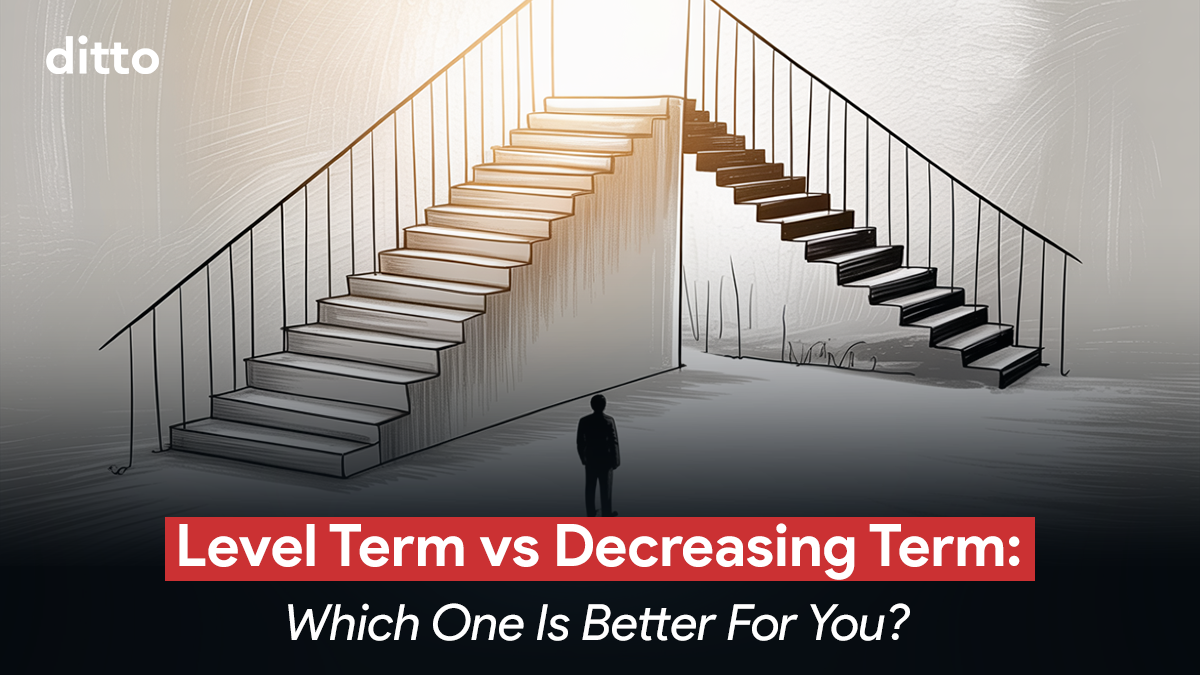| What is Level Term Insurance? A Level Term Insurance plan offers a fixed sum assured throughout the policy duration. For example, if you buy a ₹1 Cr level term plan for 30 years, your nominee will receive ₹1 Cr, regardless of whether the claim is made in year 1 or year 30. Premiums stay constant throughout. What is Decreasing Term Insurance? A Decreasing Term Insurance plan reduces your sum assured each year, typically aligning with your decreasing liabilities, like home loans. For example, a ₹2 Cr cover might reduce annually, ending at ₹50L-₹1 Cr by the end of the term. |
Paying off a loan doesn’t mean your financial responsibilities disappear. In fact, most families find that as one obligation ends, another begins, from children’s education to rising healthcare costs for parents. That’s why choosing the right type of term plan matters so much.
At Ditto, our advisors review hundreds of policies each year, and we’ve seen how each structure plays out in real life.
For this guide, we studied product brochures, IRDAI rules, and actual client scenarios to give you a clear answer: which option protects your family best, and which one risks leaving them short. By the end, you’ll know whether a level term or a decreasing term plan is the right fit for your financial future.
Want help figuring out the exact cover you need? Speak to a Ditto advisor today or check our detailed term insurance calculator to get started right away.
Level Term vs Decreasing Term: Key Differences
How Does a Level Term Plan Work?
Level term plans are the go-to for most families. They work well if you want stable protection for goals like income replacement, education funding, or just peace of mind. The cover doesn’t shrink, so you’re never underinsured. The only catch is inflation.
To put that in perspective, ₹1 crore today will only feel like about ₹50 lakhs in 20 years if prices rise at an average 4 percent a year. That means unless you pick a large enough cover from the start, your family could end up with a payout that looks impressive on paper but falls short in real life.
How Does a Decreasing Term Plan Work?
Decreasing term plans suit people with very specific liabilities. For example, if you’ve taken a large home loan, your debt falls every year as you repay it. In that case, a decreasing cover might look efficient because the protection matches the loan balance.
The premiums are lower than a level term plan, but your liabilities often don’t decline in a neat, predictable way. So once you’ve locked yourself into a shrinking policy, you could end up under-protected just when you need the safety net most.
| Did You Know? When it comes to loan-linked insurance, IRDAI sets strict rules. Your policy can never outlast your loan; so if you’ve taken a 5-year loan, your cover must also end in 5 years or earlier. The sum assured must mirror the loan balance and fall in line with its repayment schedule. The catch is, if you top up, refinance, or change the loan later, the insurance doesn’t auto-adjust. You’ll need a new policy or an amendment to stay fully covered. At the same time, the RBI is clear that banks cannot force you to buy insurance with a loan. You’re free to refuse a bundled policy and instead choose your own cover. If a banker insists, you can politely remind them of the RBI’s “no linkage” rule. In fact, most banks now work with multiple insurers, so you’re well within your rights to ask for alternatives or buy a plan independently. |
So, how do these two options stack up in real-world scenarios? Here’s our take.
Ditto’s Take: Level Term vs Decreasing Term
At Ditto, we believe the primary role of term insurance is simple: to provide dependable financial protection for your family, no matter what the future holds. While both level and decreasing term plans serve specific purposes, they’re not created equal when it comes to real-world suitability.
Take the case of a 35-year-old professional with a home loan and two school-going children. To secure their family’s future, they opt for a ₹2 crore cover till age 65 under HDFC’s Click2Protect Supreme, paying premiums for 15 years using the limited pay option.
The decreasing cover variant costs ₹37,539 annually, compared to ₹50,391 for the level cover. At first glance, that difference looks attractive. But by year 17, the cover drops to ₹1.8 crore, by year 18 it’s ₹1.7 crore, and it keeps falling by about ₹10 lakh each year, eventually ending at just ₹10 lakh in the final year. By the time the children are in college and expenses are at their peak, the protection that started at ₹2 crore has already shrunk dangerously.
This is why we recommend looking beyond the headline premium and focusing on whether the cover actually lasts as long as your family needs it.
When to Choose a Level Term Plan?
From a practical standpoint, this kind of plan is ideal if your goal is to secure your family's lifestyle, education plans, medical needs, or other long-term expenses. It also works well if you're expecting to take on new responsibilities in the future, such as caring for aging parents or sending children abroad for education.
What makes level term especially valuable is that you can lock in extensive coverage at low premiums while you're young and healthy.
| Did You Know? Life insurers must adhere to strict timelines once a claim is complete. If they delay, they might have to pay penal interest, and if they ignore the ombudsman’s (a complaints authority) decision in time, they can attract penalties. The reason insurers are held to such high standards is so that your family shouldn’t have to chase what’s rightfully theirs. What can you do better? Select an insurer with a clean claims track record, and always file your claim promptly and accurately. |
If you want to look at some good term plans that fit your needs, you can check out the best term plans here.
But what about Decreasing Term Plans? Are there any situations where they might actually be suitable?
Is Decreasing Term Insurance Ever a Good Idea?
Generally, no, we don’t recommend decreasing term insurance for most people. While it might seem logical to match your life cover with a declining loan balance (like a home loan), the reality is that your liabilities rarely decrease in a straight line.
What About “Zero-Cost” Exit Options?
Decreasing term insurance was once pitched as a cheaper way to match your falling liabilities. But today, zero-cost exit features make that logic outdated. These options let you keep your cover constant through the years, and if your responsibilities genuinely reduce, you can exit early, say after 25–30 years, and get most of your premiums back.
In short, you keep maximum protection for as long as you need it, without being trapped in a steadily shrinking cover. However, it’s important to note here that these policies come with their own caveats. To understand this in detail, you can check out our article on zero-cost term plans here.
Final Verdict: What We Recommend
At Ditto, our advice is clear:
- Start with a strong level term plan. It's reliable, predictable, and does exactly what a life insurance policy is supposed to do.
- If you can’t afford the ideal cover right away, consider increasing your coverage (by buying an additional term plan or opting for life-stage upgrades as a second-best option.
- Avoid decreasing term insurance unless you’re using it only for a specific loan, and have separate protection for your family.
As a rule of thumb,
Sufficient Level Cover > Increasing Cover > Decreasing Cover
Still unsure which one fits your needs? Speak with a ditto advisor so we can help you find a plan that truly protects what matters most.
Why Choose Ditto for Term Insurance
At Ditto, we’ve assisted over 7,00,000 customers with choosing the right insurance policy. Why customers like below Shikhar love us:
✅No-Spam & No Salesmen
✅Rated 4.9/5 on Google Reviews by 15,000+ happy customers
✅Backed by Zerodha
✅100% Free Consultation
✅Personalized recommendations
✅Real-time claim support
Conclusion
A level term plan keeps your cover steady and your family secure, no matter how life changes. A decreasing plan may look cheaper upfront, but it can leave dangerous gaps if your responsibilities grow instead of shrinking. Our advice is simple: start with a solid level term cover, and only use a decreasing plan if it’s tied to a specific loan that aligns with your long-term financial plan.
Want help figuring out the exact cover you need? Speak to a Ditto advisor today or check our detailed term insurance calculator to get started right away.
Last updated on:







